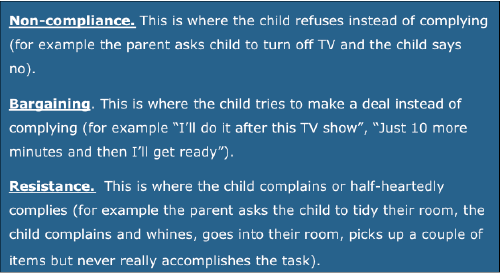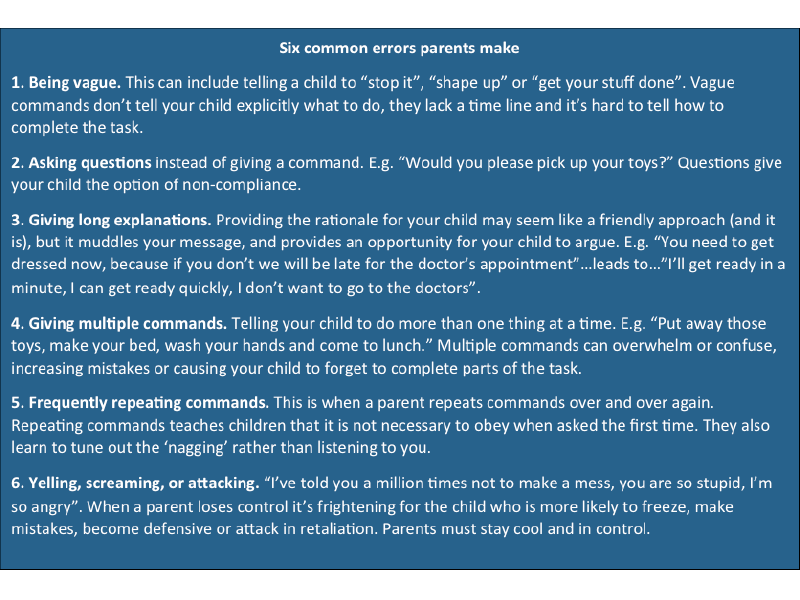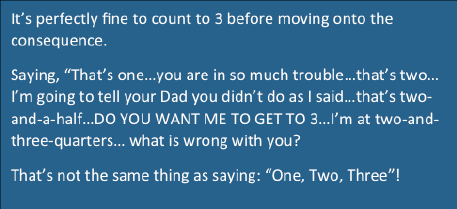It sounds so simple in theory but many parents find this really challenging. Below are some strategies on how to get your child to do what you ask and ease stress levels at the same time.
Step 1: understand the problem
Most children ignore or disobey their parent’s instructions occasionally. But if a child is frequently disobedient, and the family is stressed, then it is a problem that needs to be addressed. Let’s look at a typical parent-child interaction: First, the parent asks the child to do something such as pick up their toys or do their homework. Then the child either does what they are told (complies) or does not do what they are told (disobedience).
So what do parents do with disobedient children? In Julie’s* case, she yells or threatens until her child complies. Sometimes she has been so angry she’s scared her kids into doing what she wants, but mostly she feels like they just ignore her. Sometimes she takes away all their toys as a consequence, but they say they don’t care. And later, she feels guilty, and thinks she is a bad mum. For Dave*, he’s at the point of letting his teenage son do whatever he wants, because it’s not worth the hassle and stress. Dave is staying at work later and later because he hates the lack of respect and disobedience at home. He feels that he has lost control.
 There are three common forms of disobedience: non-compliance, bargaining and resisting. Some children may appear expert in one of these areas, but the majority are able to switch between them all.
There are three common forms of disobedience: non-compliance, bargaining and resisting. Some children may appear expert in one of these areas, but the majority are able to switch between them all.
As time goes on, the problems seems to be getting worse, affecting their relationships with their children and their partners. For Julie, Dave, or any parent to break the pattern and solve the problem, the PARENT has to change how they approach the disobedience.
Step 2: ask effectively
While Dave has stopped asking altogether, Julie is worried about issuing commands to her children in case it impacts their relationship. She wants to be her children’s friend, and she wants them to be on her side and just help without her having to threaten them. Typically she starts off by asking them questions, and when that doesn’t work, she gets upset and starts yelling. Her kids tend to ignore her until she is screaming.

Think for a moment about what it would be like to go to a workplace without anyone in charge, or with someone who was too polite to tell others what to do. A workplace where no-one did the jobs that needed doing, or where the team refused to comply with directions. Imagine how stressful that environment would be. The best organisations in the world have someone in charge, someone who is a leader, a coach, someone who inspires others to reach their potential. In a family, this is the parents. And just like having a poor manager can cause problems, often the way parents tell children to do tasks can contribute to problems in a family.
The most important step in overcoming disobedience is giving effective commands. This means providing a specific, one step command in 10 words or less.
For Julie this means saying “Turn off the TV now”, instead of “Would you turn off the TV please?” and, “I want you to get dressed by 7.30am” rather than “Why are you taking so long to get ready?”
Short, specific commands will help her children to become compliant because they tell her children exactly what is expected of them. When they get it right she can praise them. And when they don’t comply she can use a consequence rather than yelling.
For Dave, it’s about understanding what consequences he can use, and what things are important for him and his family.
Step 3: use rewards and consequences appropriately
Julie does not need to yell for her children to know she is serious, but she does need to have a consequence. Consider for a moment that we don’t get yelled at in the workplace or at school – but we do follow rules because there are consequences for not complying with directions.
Short, specific commands help children to become compliant because they tell the child exactly what to do to be successful. And they help parents decide what to do next.
Remember the basics – when your child complies, praise and reward them. When your child is disobedient, issue a clear warning and, if necessary, a consequence.
Many families find it helpful to write a list of potential consequences out together during a quiet time. Include your children in making the consequences list – discuss what consequences apply (for example the consequence for staying out past a curfew is likely to differ from what happens when a child doesn’t tidy their room). Consequences typically involve a loss of privileges, such as taking a time out, losing TV time, not being able to play the computer, missing out on a planned event, or losing a toy.
Deciding on consequences beforehand helps prevent parents choosing consequences that are unenforceable, inappropriate, or out of proportion to the disobedience. (For example taking away the computer for a month when the child needs it for school is inappropriate, and saying “no TV for a year” is too hard to enforce.Consequences include warnings and then a specific outcome (perhaps being suspended from school or losing a job).
How to issue a clear warning:
- Make eye contact with your child
- Raise your voice slightly. (No yelling)
- State your warning once only
- Use an “If….then” statement. For example you might say “If you don’t tidy your room now, then you will (have a privilege removed)”
Families also need to have clear consequences about what happens for disobedience. Consequences include:
- Losing a privilege until the child complies (for example, no TV until homework is done)
- Losing a privilege for a specified period of time (for example, no more TV this morning, no phone for 24 hours, being grounded for 3 days).
Step 4: stay calm and be consistent
Most parents say Step 4 is the hardest and it’s probably the true secret of child whisperers, horse whisperers and many other experts!
Staying calm is ranked by many parents as the hardest part of the process, second only to remembering to stay consistent.
 Many parents say it’s useful to have a family meeting, to get everyone on board, and to pin up consequences somewhere that’s easy to see when you need them.
Many parents say it’s useful to have a family meeting, to get everyone on board, and to pin up consequences somewhere that’s easy to see when you need them.
This will help her avoid getting into a power struggle with her child, losing her temper, getting caught up in the ‘disrespect’ or deciding in the heat of the moment to change the consequences, or to fall back into old unhelpful patterns.They also find it helpful to practice using commands and consequences. For Julie, she could write out what she might say. For example, “Sam, get dressed now”. She could plan what the consequence will be, and rehearse the warning: “Sam, if you do not get dressed now, you cannot play Minecraft today after school”. It is perfectly fine to count to 3 before issuing the consequence, especially if your child is aged 3-10 years. Julie could also pin up a note or put a reminder into her phone saying ‘No Minecraft tonight’ so she remembers to follow through with the consequence.
If Julie remains calm, she will increase the chances of success in shaping her children’s behaviour and in building a healthy relationship.
But for Julie, and all parents, it’s important to remember that sometimes, behaviour gets worse before it gets better –a child may feel like testing out whether the parent really will apply the consequences, or whether they’ll only follow through sometimes. They’ll be checking to see if the parent means it. Don’t be discouraged, this is your child learning. Children learn quickly in consistent environments, so the more consistent parents are, the quicker children learn what will happen when they don’t obey your instructions. Don’t forget to praise them (or use rewards like sticker charts for younger children) to re-enforce when they get it right. Celebrate success and expect a few mistakes along the way.
If you find that you’re having trouble staying calm, or if there’s too much yelling or if there is physical conflict, it’s recommended that you consult a mental health professional to learn additional strategies.
*Names changed.

